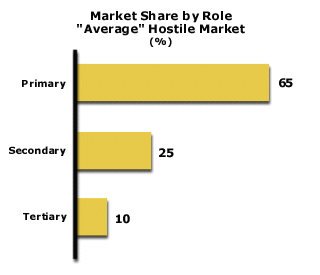THE BIG SLICE OF THE PIE
by Donald V. Potter
The head of one industry leader explains his company’s insistence on being a key supplier to each of his company’s customers.
“The guy with the big slice of the pie doesn’t go hungry.” The workings of the typical hostile market provide solid support for this philosophy.
Bigger IS Better
In hostile markets, customers especially channel customers, will have several suppliers, each of which fills a different role.
- The Primary Supplier is the supplier on whom a customer relies for most of its volume. Often, the supplier and customer have a long-standing relationship.
- The Secondary Supplier provides insurance against disruption in supply from the primary supplier and against unwarranted price increases. A secondary supplier usually gets enough volume to warrant a steady relationship with the customer.
- The Tertiary Supplier fills a limited role, usually providing either a specialized product or a discounted price that can be useful as leverage with the other suppliers.
The market pie is divided very unequally among these three supplier roles. As shown in the exhibit below, which represents an “average” hostile market based on several markets we have studied over the years, market volume goes disproportionately to the supplier in the primary role. In this example, the primary position is more than 2-1/2 times the size of the secondary position, which in turn is 2-1/2 times the size of the tertiary position.
Clearly, bigger is better. Any company that would be a major player in the marketplace must draw the bulk of its volume from the primary position. In one market we recently examined, we found the industry leader, with 35% of the market, had nearly 90% of its volume in primary positions with its customers.
Leading Role Offers Growth
In many hostile markets, the primary position tends to grow at the expense of both the secondary and the tertiary positions. This occurs because customers tend to consolidate their volume, in part to simplify the buying process but more fundamentally to get lower prices. As the volume purchased increases, suppliers tend to reduce their price to that customer accordingly. Most astute suppliers will offer customers significant incentives to consolidate volume with them.
For example, one industry leader offered a free service package to any customer, regardless of its size, if that customer would give him two times the volume of the next largest supplier in the relationship.
Primary Supplier Is Most Profitable
In a hostile market, virtually all suppliers to a given customer will charge that customer the same price. The only exception would likely be a “price shaver,” usually a tertiary supplier, who offers price discounts of 2-5% in order to gain some volume.
While prices will be the same, unit costs will vary with volume sold to that customer. So profit within the customer relationship will be directly proportional to volume.

As the exhibit shows, in an “average” hostile market, the primary supplier receives 2-1/2 times the volume of the secondary supplier and 6-1/2 times the volume of the tertiary supplier. The primary supplier is positioned for greatest profitability.
The importance of the primary position brings with it a corollary: The tertiary position is, in many cases, unattractive. The leading suppliers in an industry normally would accept a tertiary position in a customer relationship only when they are unloading marginal volume-or when they see a genuine opportunity, over time, to improve their position into a secondary or primary position with the customer.
Closing Thought
Knowing that the primary supplier role is most attractive is only a beginning. The real challenge lies in preparing to get this lead role.
(Note: This Perspective was written in the context of the economy in 1995. While some of the companies may have changed their policies or indeed no longer exist, the patterns they exhibit still hold today.)
| Recommended Reading |
| For a greater overall perspective on this subject, we recommend the following related items:
Analyses:
Symptoms and Implications: Symptoms developing in the market that would suggest the need for this analysis.
*** |
